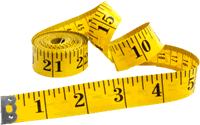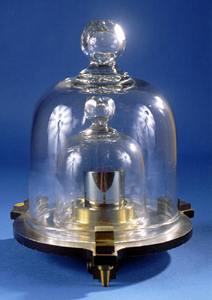| Science depends on observation and measurement and measurement in turn requires standards for comparison. Syllabus referenceStructure 1.1.3 - The temperature, T, in Kelvin (K) is a measure of average kinetic energy Ek of particles.
Guidance
Tools and links
|

|
All measurements are made relative to some agreed standard. This is to allow adequate communication and understanding between scientists. The dimensions are the units of the concept being measured broken down into basic units.
The most used international system of measurements is called the S.I. - 'Systeme Internacionale'.
 This
is measured in grams and kilograms (1000g). The kilogram is the base unit
of the S.I. system.
This
is measured in grams and kilograms (1000g). The kilogram is the base unit
of the S.I. system.
The metre was originally defined as 1/10,000,000 of the distance between the equator and either pole. This is clearly inaccurate and it was later defined as the distance between two marks on a bar made of a platinum-iridium alloy, kept at Sevres, France.
More recently, the metre has been defined as the distance light travels through a vacuum in 1/299,792,458 of a second.
Mass is measured in kilograms. The SI system defines the unit as equal to the mass of the international prototype of the kilogram, which is made from an alloy of platinum and iridium of 39 mm height and diameter, kept at the Bureau International des Poids et Mesures (International Bureau of Weights and Measures). Official copies of the prototype kilogram are made available as national prototypes, which are compared to the Paris prototype ("Le Grand Kilo") every 10 years.
The international prototype kilogram was made in the 1880s.
The melting point of water and boiling point of water were chosen as the basis of the centigrade (now called Celsius) scale of temperature measurement by Anders Celsius in the 18th century. He decided that the melting point (freezing point) and boiling points of water should be the points of reference and that there should be 100 'degrees' difference between them.
The melting point of water would be assigned a value of 0ºC and the boiling point of water 100ºC. This gives a range covering the temperatures that we are likely to find in everyday life. It is a relative scale, comparing the temperature to the melting and boiling points of water.
Temperature has an absolute zero at the temperature when the particles present have no energy. This zero energy point is assigned a temperature of zero on this absolute scale - called the Kelvin scale. Zero Kelvin is equivalent to -273.15º on the Celsius scale (usually approximated to -273ºC). It is physically impossible to go "below" absolute zero as this would require having less than zero energy!
Time is measured in seconds, s. The actual value of a second has been defined several times over the years and now depends on the time taken for a fixed number of waves of a caesium atom when excited.
The time taken for the passage of 9,192,631,770 wavelengths of the radiation corresponding to the transition between the two hyperfine levels of the ground state of the caesium 133 isotope. (don't worry, you don't need to know this!)
Relative means in comparison to an accepted value. While nearly all measurements are fundamentally relative, those given with units are not considered to be so.
